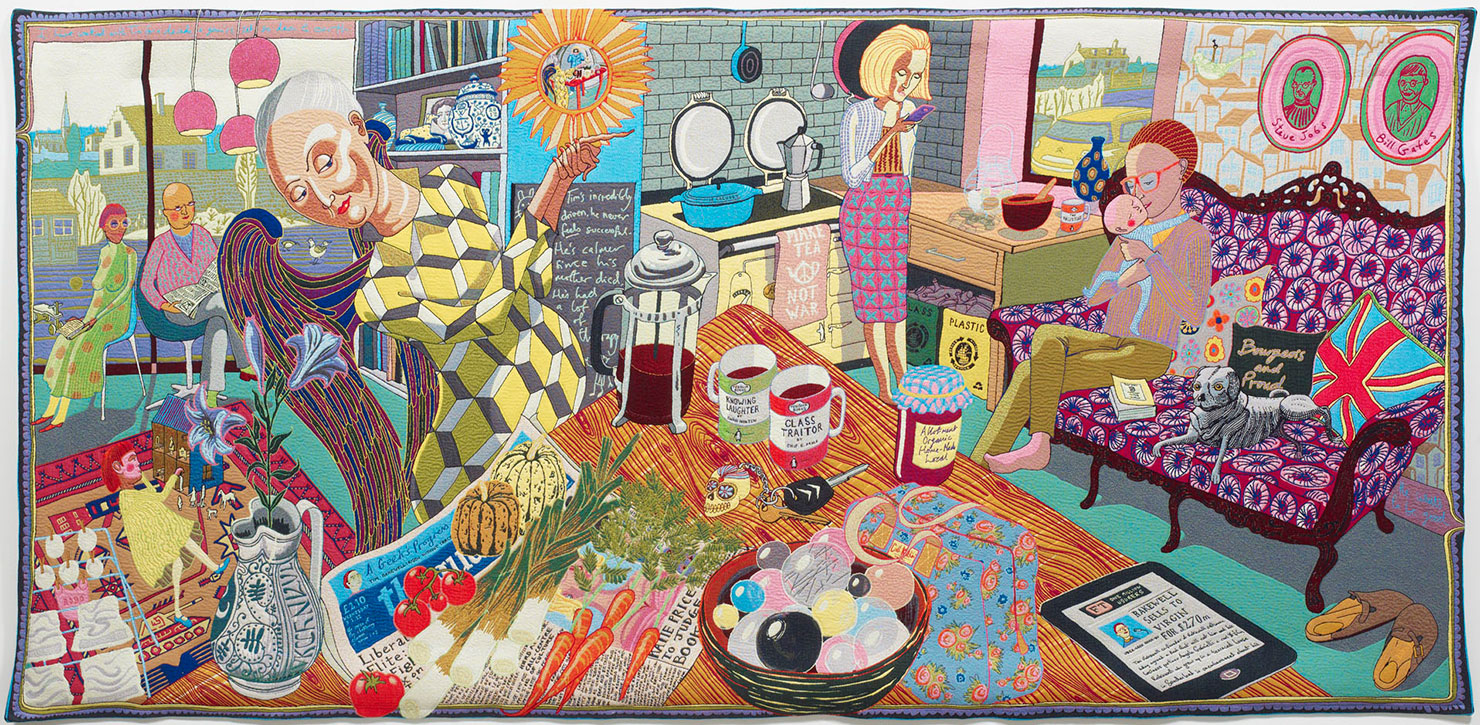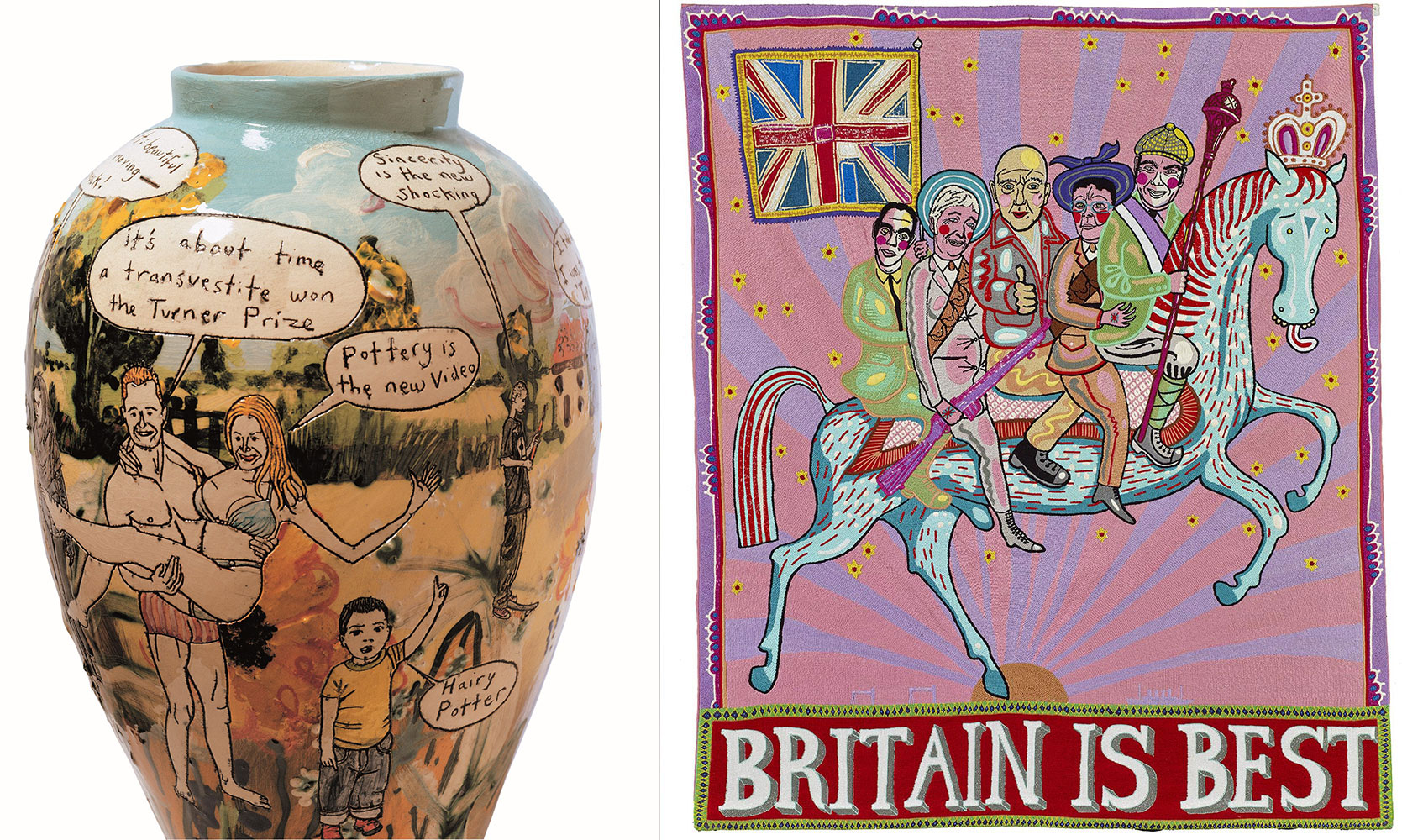PREVIEW: Grayson Perry-Fitting In and Standing Out
 Grayson Perry is mainly for his ceramic vases and cross-dressing. Perry’s vases have classical forms and are decorated in bright colours, depicting subjects at odds with their attractive appearance. There is a strong autobiographical element in his work, in which images of Perry as “Claire”, his female alter-ego, often appear. He was awarded the prestigious Turner Prize in 2003 and in 2011 combined his own works with historical artefacts from the British Museum collection in the exhibition “Grayson Perry: The Tomb of the Unknown Craftsman”.
Grayson Perry is mainly for his ceramic vases and cross-dressing. Perry’s vases have classical forms and are decorated in bright colours, depicting subjects at odds with their attractive appearance. There is a strong autobiographical element in his work, in which images of Perry as “Claire”, his female alter-ego, often appear. He was awarded the prestigious Turner Prize in 2003 and in 2011 combined his own works with historical artefacts from the British Museum collection in the exhibition “Grayson Perry: The Tomb of the Unknown Craftsman”.
By Dimitris Lempesis
Photo: National Museum Of Norway Archive
Grayson Perry grew up in suburban Essex and sought refuge from a troubled childhood in an imaginary world ruled over by his teddy bear, Alan Measles. At Portsmouth Polytechnic and later, living in a London squat, he was part of a post-Punk group of artists, musicians and film-makers, particularly the Neo Naturists, a performance art collective connected to the New Romantic club scene. Perry has described this early period as the “pre-Therapy years”, a time when he explored his complex identity through his art, expressing an anger which would later be resolved through psychotherapy. His imagery could be deliberately shocking, sometimes combining Nazi symbols (a trait of British Punk), religious iconography and graphic scenes of unorthodox sexual activity. At the same time, his work satirised such social themes as class and gender and, especially, the conventions of the art world of which he was increasingly a part. The exhibition “Grayson Perry. Fitting In and Standing Out” is wide-ranging and in addition to ceramics and include wood and metal sculptures, prints, monumental tapestries, and embroidery. A recurring theme is the provocatively humorous pictorial stories that are a trademark for Perry, who started experimenting with ceramics in the 1980s. Grayson Perry is acclaimed for his ceramics, sculptures in iron and bronze, drawings, prints and ambitious, large-scale tapestries which chronicle contemporary life and society. Various themes are explored through his multi-faceted practice including the history of taste and social class in Britain, religious and folk iconography, and representations of sexuality and masculinity. With a keen eye for detail and a love of the popular and vernacular, Perry infuses his artworks with a sly humour and reflection on society past and present. The “Walthamstow Tapestry” (2009) presents the story of a man’s life from birth to death as he journeys across a landscape dotted with the brand names of a typical English high street, fast-food chains, electronics giants, supermarkets. The design and execution reminiscent of a medieval tapestry, only one with motorbikes and Louis Vuitton handbags. The six-part tapestry cycle “The Vanity of Small Differences” (2012) updates William Hogarth’s Rake’s Progress (1733) with the story of the rise and fall of Tom Rakewell, a computer software millionaire who dies a tragic death when he crashes his sports car into a lamppost. For this, and in other works too, Perry’s drawing style is reminiscent of cartooning and street art, an ungodly mix ubiquitous on cafe walls the world over. Perry’s most celebrated works are his ceramics, big pots in various shades of black and gold that chart personal stories of his transvestism and alienation from mainstream British society, works that carry more than a hint of sorrow and bitter sarcasm. The artist’s highly decorated pots in particular reveal a panoply of imagery ranging from the highly personal to the political, their subjects including his own family, the art world, Biblical stories, the royal family, and images of warfare and sexual fantasy. Perry’s transvestism and feminine alter ego ‘Claire’ emerges through his practice as a recurring visual motif. A contemporary of the YBA (Young British Artists) generation, he has forged a distinctive career that sits apart from the cooler theoretical approach of some of his peers, favouring a more flamboyant, accessible aesthetic that blurs the division of high art and popular culture. The large tapestry “Battle of Britain” (2017) shows an imaginary British landscape crowded with allusions to feelings and issues dividing the country. The artist’s highly decorated pots in particular reveal a panoply of imagery ranging from the highly personal to the political, their subjects including his own family, the art world, Biblical stories, the royal family, and images of warfare and sexual fantasy. Covered with sgraffito drawings, handwritten and stencilled texts, photographic transfers and rich glazes, Perry’s detailed pots are deeply alluring. Only when we are up close we start to absorb narratives that might allude to dark subjects such as environmental disaster or child abuse, and even then the narrative flow can be hard to discern. Just as an apparently benign or conservative medium such as ceramics is used to convey challenging ideas, Perry’s tapestries take an art form traditionally associated with grand houses – depicting classical myths, historical and religious scenes and epic battles – and play with the idea of using this ancient allegorical art to elevate the commonplace dramas of modern British life. Politics, consumerism, history and art history are bound up in the work, in both subject and medium. Yet, for Perry, emotional investment – making work about the things we care about – is key. As he says: “An emotional charge is what draws me to a subject”. The two large vases “Matching Pair” (2017) have been decorated with images chosen and supplied by the two groups of British public… those that voted for the UK to leave the European Union in the 2016 referendum, and those that voted to remain, were asked to contribute visual material via social media. In “We Shall Catch it on the Beaches” (2020), we see famous British figures, such as Queen Elizabeth and Chris Witty. It is also a sharp take on social hypocrisy, as the phrase “Fair pay for key workers apart from our cleaner, oh and the nanny” demonstrates. The title of the vase refers to a speech during World War II, “We Shall Fight on the Beaches”, by Winston Churchill in 1940. And the shape of the vase refers to a flagon, a robust medieval jug widely used in Britain at the time.
Photo: Grayson Perry, The Annunciation of the Virgin Deal, 2012. From the series The Vanity of Small Differences, edition of 6 plus 2 Aps. Courtesy the artist and Victoria Miro, London, © Grayson Perry
Info: Curator: Knut Astrup Bull, The National Museum Of Norway, Brynjulf Bulls plass 3, Oslo, Norway, Duration: 11/11/2022-23/3/2023, Days & Hours: Tue-Sun 10:00-21:00, www.nasjonalmuseet.no/

Right: Britain is Best, 2014. Hand embroidery; silk, glass beads, sequins, cotton thread. Edition of 20 plus 4 AP, Published by Paragon Press. Collection the Artist. Image courtesy Paragon Press and Victoria Miro, London © Grayson Perry


Right: Grayson Perry, Death of a Working Hero, 2016. © Grayson Perry. Courtesy the artist, Paragon | Contemporary Editions Ltd and Victoria Miro


Right: Grayson Perry, Map of Nowhere (blue), 2008. Colour etching from five plates. Edition of 15 plus 4 AP. Published by Paragon Press. Collection the Artist. Image courtesy Paragon Press and Victoria Miro, London © Grayson Perry

